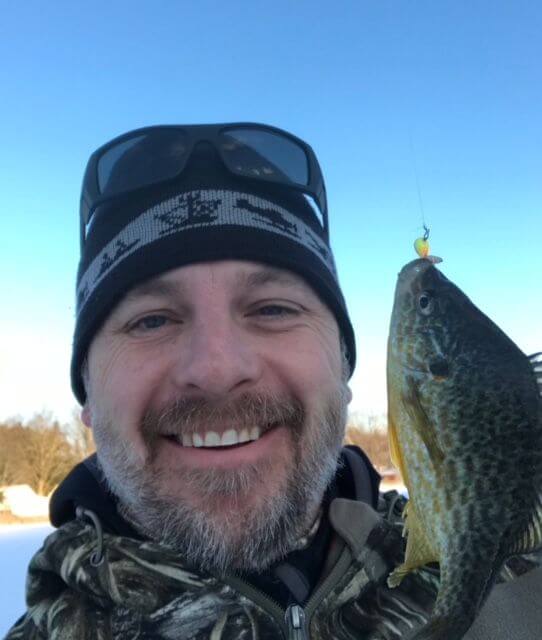This is it. Right here. Start drilling.

I had an old Jeep CJ-7 whose floorboard had rotted out, and we installed a sheet-metal door on hinges in its place, so we could drive out on the ice and, with the heater running, jig through the floorboard door. We kept a big pickle bucket in the back seat and tossed the fish in it when we caught them. Sometimes we would fill a half bucket or so. This would bring great pride because we could drive them back to Ralph’s place, and he would instruct us on how to clean them into “crispy tails”—two pieces of meat on each side of the backbone and the tail still attached. We would fry them up in vegetable oil with flour, corn meal, salt and pepper batter and eat them late into the night, laughing and cajoling and telling stories about the one that got away.
The central theme of this new obsession was the enthusiasm and joy it brought us to pull something live out from underneath a frozen lake. The thump of the jig in our hands, the pull of the fish and the gorgeous amber color with seven stripes on each of the yellowbellies. Now, some 30-odd years later, I am witnessing a new convert and his boundless enthusiasm as he learns the sport, with all new equipment but still with the same old techniques—minus the floorless Jeep.
My dear friend, Doug Hartwell of Vergennes, has been bitten and I fear is developing serious case of piscatorial fever. Doug is an engineer and seems to be capable of just about anything that can be diagrammed or fabricated using design technology. His first year of ice fishing was full of frustration. He would ask a lot of questions and soak up technical information like the proverbial sponge, but he just couldn’t yet grasp the “right time/right place/right condition” format. He thought that if there are fish down there (and there always were) and if he presented them with the right lure/bibbit/minnow, that of course they should bite!
His enthusiasm and desire to get it right carried him through that first year, and his failures to catch a lot of fish just threw gasoline on the fire in his belly to learn this sport. He acquired equipment at a slow pace, preferring to repair other fishermen’s castoffs and use his engineering genius to modify the pieces into more serviceable weapons. And he never stopped asking questions.
One day, after a particularly frustrating attempt, he broke down and asked, “Why? What am I missing? Is it the equipment, the technique, the locations, the weather, the barometric pressure, the color of the bibbits (tiny teardrop shaped lures)…what the heck is it?” To which I shared the piece of wisdom that Ralph Learned told me when I asked the same question; “Yes. It’s all those things—all at the same time—and more than any of those it’s art, not science that catches fish.” And to this day I believe that to participate in the great cycle of life one has to meet all the prerequisites of technique and skill, but, most important, we have to allow ourselves to listen to the inner voice that guides us to where the fish are. As we walk across the frozen surface, we watch our depth charts on our iPhones and notice that the sun is still low on the horizon, the clouds are building in from the northwest, and the barometer is dropping. With all this knowledge it still largely depends on what “feels right.” We take two more steps and the feeling that we are a part of all of this wonder washes over us. “This is it. Right here. Start drilling.”
Bradley Carleton is executive director of Sacred Hunter, a nonprofit that seeks to educate the public on the spiritual connection of man to nature.

